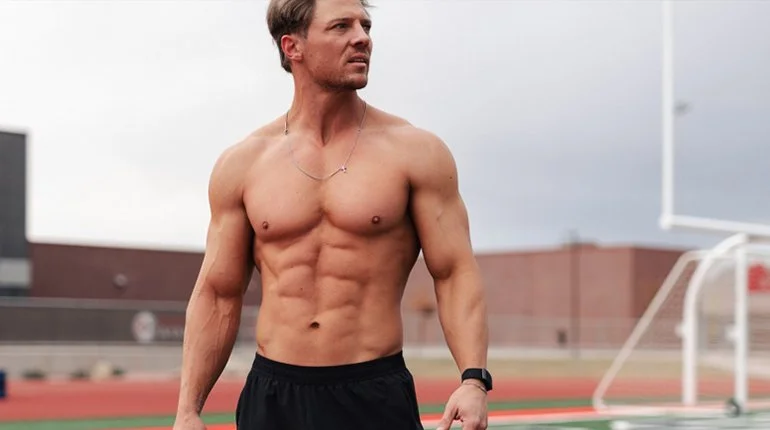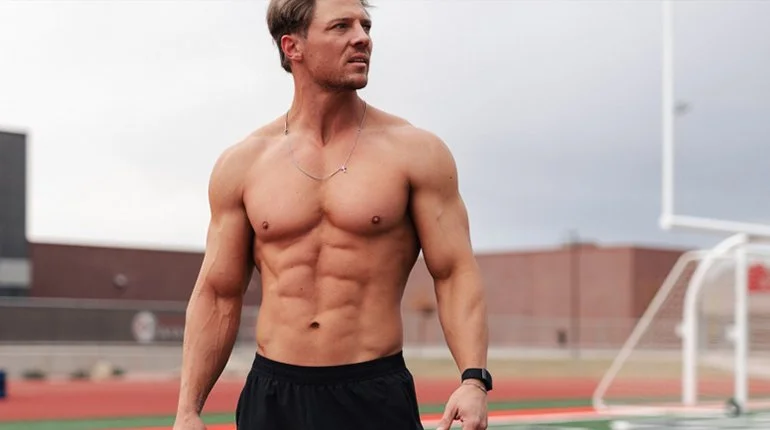Athletically Aesthetic - The Byproduct Body.
Discover the key differences between training for aesthetics versus athleticism in this in-depth article. Learn why focusing on athletic-based training not only enhances performance but also naturally leads to a well-defined, aesthetically pleasing physique. Explore the benefits of functional exercises, and find out how training like an athlete can improve your overall health, longevity, and daily life, while still achieving the body you desire. Perfect for fitness enthusiasts seeking a more sustainable, performance-driven approach to their workouts.
In the world of fitness, there’s a growing divide between two dominant approaches: training for aesthetics and training for athleticism. While both methods have their merits, the benefits of focusing on athletic training extend far beyond mere appearance, offering a more holistic approach to health, performance, and longevity. In this article, we'll explore the differences between these two philosophies and explain why training for athleticism often leads to not just a capable body but also an aesthetically pleasing one—albeit as a secondary outcome.
The Pursuit of Aesthetics.
Aesthetic training is often the go-to for those seeking a visually appealing physique. It involves a focus on hypertrophy (muscle growth), symmetry, and muscle definition. Bodybuilders, fitness models, and many casual gym-goers often prioritize this approach, aiming to sculpt their bodies to resemble the idealized figures celebrated in magazines and on social media.
While there's nothing inherently wrong with wanting to look good, the primary focus of aesthetic training is on appearance. This approach emphasizes isolated muscle work, often using machines or specific exercises that target certain muscle groups to create that chiseled, symmetrical look. However, aesthetic training can sometimes come at the expense of functional performance. For example, a bodybuilder might have an impressive physique, yet lack the agility, speed, or endurance that characterizes athleticism.
The Power of Athletic Training.
On the other side of the spectrum is athletic training. This approach is rooted in the development of performance-related attributes: strength, speed, power, endurance, agility, and coordination. Athletes train with the goal of excelling in their chosen sport, focusing on movements that mimic real-life activities and enhance their ability to perform under pressure.
Athletic training often involves compound exercises that work multiple muscle groups simultaneously, such as squat variations, deadlift variations, and Olympic lifts. These movements not only build strength and power but also improve balance, coordination, and flexibility. Functional training, plyometrics, and sport-specific drills are also staples of athletic training, all designed to enhance performance in real-world scenarios.
One of the most compelling benefits of training like an athlete is the carryover effect into daily life. A person who trains athletically can run faster, jump higher, lift heavier, and move more efficiently. This functional fitness translates into better quality of life, reducing the risk of injury and enabling a more active, capable lifestyle.
Athletic Training Leads to Aesthetics—Naturally.
Interestingly, when you focus on training for performance, aesthetics often follow as a natural byproduct. The rigorous, dynamic movements involved in athletic training promote muscle growth, fat loss, and improved body composition. As you become more proficient in these exercises, your physique starts to reflect the hard work. Muscles become more defined, your posture improves, and your body takes on a lean, athletic appearance—one that is not only visually appealing but also highly functional.
Unlike aesthetic training, which can sometimes lead to imbalances or overemphasis on certain muscles, athletic training develops the body in a more balanced and harmonious way. The result is a physique that not only looks good but is also capable of impressive feats of strength, speed, and endurance.
The Long-Term Benefits of Athleticism.
The benefits of athletic training go beyond the physical. Engaging in athletic activities promotes mental resilience, discipline, and a strong work ethic. The focus on performance-based goals rather than superficial ones encourages a mindset of continuous improvement and perseverance. This mental toughness is often what separates true athletes from those who simply chase an idealized image.
Moreover, athletic training tends to be more sustainable in the long run. While aesthetic-focused training can lead to burnout or injury due to repetitive, isolated movements, athletic training's varied, functional approach keeps the body engaged and reduces the risk of overuse injuries. The diverse nature of athletic training also keeps workouts interesting, helping maintain motivation over time.
The Best of Both Worlds.
Ultimately, the choice between training for aesthetics and training for athleticism comes down to personal goals. However, the benefits of athletic training—enhanced performance, functional strength, and mental resilience—are undeniable. And the best part? By focusing on developing your athletic abilities, you naturally cultivate an aesthetic physique that is both visually striking and practically powerful.
Training like an athlete means embracing the idea that form follows function. It’s about prioritizing what your body can do over how it looks—and in doing so, achieving a physique that not only turns heads but also stands the test of time.
Example of a Simple Athletic-Based Training Session.
Total Time: 60 minutes (15-minute warm-up + 45-minute workout).
Warm-Up (15 minutes):
1. Dynamic Stretching (5 minutes): Start with dynamic stretches to prepare your body for the workout. Include movements like leg swings, arm circles, and torso twists to increase blood flow and enhance flexibility.
2. Mobility Drills (5 minutes): Focus on mobility exercises such as deep lunges with a twist, inchworms, and shoulder dislocates to improve joint mobility and range of motion.
3. Agility Drills (5 minutes): Finish the warm-up with quick feet drills, lateral shuffles, and high knees to activate your nervous system and get your heart rate up.
Workout (45 minutes):
1. Compound Weighted Exercises (20 minutes):
Seated Single Leg Squats (4 sets of 8-10 reps per leg): This unilateral exercise builds leg strength, balance, and stability. Sit on a bench or box, then stand up using one leg, focusing on control and balance. Alternate legs after each set.
Pull-Ups (3 sets of 8-10 reps): Engage the upper body with this compound exercise that works the lats, biceps, and shoulders. If needed, use assistance bands or a pull-up machine.
Deadlifts (4 sets of 5-6 reps): A power move that engages the entire posterior chain, including the hamstrings, glutes, lower back, and traps. Ensure you're using proper lifting technique to avoid injury.
2. Bodyweight Exercises (15 minutes):
Plyometric Push-Ups (3 sets of 10-12 reps): Explosive push-ups that increase upper body power and engage the chest, triceps, and shoulders. Aim to push off the ground with enough force to lift your hands off the floor.
Bulgarian Split Squats (3 sets of 10-12 reps per leg): A unilateral leg exercise that builds strength, balance, and stability. Use your body weight or hold dumbbells for added resistance.
Hollow Body Hold (3 sets of 30-45 seconds): A core-strengthening exercise that targets the abs and improves overall stability. Focus on keeping your lower back pressed into the ground while maintaining tension in your core.
3. Agility Work (10 minutes):
Cone Drills (4 sets of 30 seconds on, 30 seconds off): Set up cones in a zig-zag pattern and work on quick directional changes, focusing on speed and agility. Alternate between forward sprints, lateral shuffles, and backpedals.
Ladder Drills (4 sets of 30 seconds on, 30 seconds off): Use an agility ladder to perform drills like high knees, lateral steps, and in-and-out hops. This improves foot speed, coordination, and agility.
Cool Down (5 minutes).
After completing the workout, spend 5 minutes doing light stretching and deep breathing exercises to help your body recover and return to a resting state.
Why “healthy” isn’t enough.
Discover why “fitness” is more than just “health” at Resilient not Reliant. Learn how prioritizing physical and mental fitness builds true resilience, empowering you to thrive in an unpredictable world. Join us to achieve peak performance and live life on your terms. Explore our comprehensive approach to fitness and become part of a community dedicated to strength, independence, and preparedness.
In today's world, the words "health" and "fitness" are often used interchangeably. However, at Resilient not Reliant (RnR), we believe there's a fundamental difference between the two, a difference that is crucial to understand if we are to build a truly resilient community.
Our focus on "fitness" rather than "health" reflects our commitment to a higher standard of physical and mental well-being—one that goes beyond merely avoiding illness to achieving peak performance and adaptability.
Fitness vs. Health: Understanding the Distinction.
Health is commonly associated with just the absence of disease. It's a passive state, often defined by what is not present—illness, injury, or disease. While being healthy is undoubtedly important, it is not enough if our goal is to thrive and excel in a rapidly changing world. Health is the baseline, but it does not necessarily equip us to face and overcome the myriad challenges that life throws our way.
Fitness, on the other hand, is an active state of being. It is defined by our ability to perform and outcompete others within our environment. Fitness encompasses strength, endurance, flexibility, and mental fortitude. It’s about being prepared, both physically and mentally, to tackle obstacles, recover quickly from setbacks, and continually improve.
Our Two Pillars of Fitness: Physical and Mental
At RnR, we categorize fitness into two main areas: physical fitness and mental fitness. Both are essential for building true resilience.
1. Physical Fitness: This goes beyond just being free from disease. It’s about pushing our bodies to their limits and then surpassing those limits. Physical fitness includes cardiovascular endurance, muscular strength, flexibility, and agility. It’s about being able to lift, run, jump, and move with ease and power. Physical fitness ensures that we have the energy, strength, and durability to handle the physical demands of everyday life and unexpected challenges.
2. Mental Fitness: Just as important as physical fitness, mental fitness is about cultivating a mindset that is resilient, focused, and adaptable. It involves developing mental toughness, emotional regulation, and cognitive flexibility. Mental fitness means being able to stay calm under pressure, think clearly in high-stress situations, and maintain a positive and proactive outlook, no matter the circumstances.
Why Fitness Matters.
Choosing to focus on fitness rather than health is about striving for excellence rather than settling for mediocrity. It’s about preparing ourselves to thrive in an unpredictable world. Here are some key reasons why fitness is central to our philosophy:
1. Resilience: Fitness builds resilience. It enables us to withstand and recover from adversity. Whether it’s a physical challenge like running a marathon or a mental challenge like managing stress, being fit means being prepared.
2. Performance: Fitness enhances performance in all areas of life. It improves our physical capabilities, cognitive function, and emotional well-being. A fit person performs better at work, in personal relationships, and in their hobbies and passions.
3. Longevity: Fitness contributes to a longer, healthier life. Regular physical activity and mental exercise can prevent chronic diseases, improve mental cognition, and increase overall life satisfaction.
4. Empowerment: Fitness empowers us to take control of our lives. It gives us the confidence and capability to face challenges head-on and overcome them. It enables us to live life on our own terms.
Our Commitment to Fitness.
At RnR, we are dedicated to providing the highest quality knowledge, training, and equipment to help you achieve a peak level of resilience. We believe that by optimizing for greater fitness, along with finances and preparedness, we can build a community of strong, resilient, and adaptable individuals.
Our choice to focus on fitness rather than health is about setting a higher standard for ourselves and our community. It’s about striving for excellence and building true resilience. By optimizing for fitness, we are not just being healthy; we are preparing ourselves to thrive in an ever-changing world.
Join us on this journey to become stronger, both physically and mentally, and to build a community of resilient, not reliant individuals.



